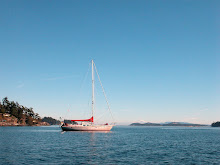
Saturday, August 15, 2009
Farewell Fair Weather

Tuesday, August 11, 2009
New Friends, Memorable Places
Not wanting to miss another chance to get to know Whisper, we invited them over for coffee and dessert. Over bread pudding we exchanged stories of how we ended up in the Azores and then Svalbard. The crew of Whisper are four friends who recently graduated from university. Piotreu and Magdalena purchased Whisper, a Cal 29 in Michigan and sailed to Poland via the Caribbean before heading to Svalbard. With various friends joining them along the way.

It was a memorable evening and we look forward to sharing another anchorage with Whisper 2.
Monday, August 10, 2009
The Harsh But Fragile Arctic

Magdalene's deep water, spectacular glaciers and steep peeks make it one of Svalbard's most famous fjords. With Trinityhamna, a 17th Century whaler burial ground being a popular shore stop. Over the years, thousands of tourists have walked among the graves without regard for the soft soil and fragile vegetation beneath their feet.
The devastation to both the vegetation and the grave site prompted the Sysellmennen to take the unusual action of surrounding the graveyard with a fence. While we were there, none of the cruise ships that came into the fjord disembarked but even so there was evidence of heavy foot traffic.
The Arctic terns provide their own security. When we tried to walk along the beach they immediately attempted to attack us. This was the first time that we found terns in Svalbard to be aggressive and they were clearly tired of being disturbed, even though we were a respectful distance from their nests.
It was quite sad seeing the fence, which looked completely out of place in a fjord that is known for its natural beauty. With care, the vegetation will return but some estimate that it could take up to 200 years. Time will tell but it is a clear reminder that Svalbard is still struggling to find the right balance between tourism and conservation.
For more photos of Magdalene please click on Magdalenefjord Album.
Last Stop

Ny Alesund, our last stop in “civilization” is owned and operated by Kings Bay which successfully turned the settlement into a scientific research base, after coal mining became unprofitable. Several countries have permanent stations there including Norway, Holland, China and India, making it an international community.
Before we left the pub, word got around that Saturday was dance night and we were told it was an event not to be missed. Our plan had been to only spend two days in Ny Alesund but we decided to stick around. The extra time in town also gave us the opportunity to repair Angela who ended up needing her motor replaced, luckily we had a spare on board.
Just as the repair was completed, a few members of the NASA team stopped by to see our “battle ship”. They were impressed by her construction and kept comparing her to a plane. Though they understood a lot of the systems and navigational equipment, they were not sure how long they would last at sea. Maybe one day some of them will join us and find out.
To escape the cruise ships that come into Ny Alesund, we took a day to explore the nearby island of Blomstrand which had good hiking and a friendly young reindeer who followed us around. After spending time in an idyllic anchorage, we headed back to town. Though the dance was not the most happening event, we enjoyed spending more time with our new friends.
Before we left the following morning, they took us out to see the plane in action. It was fascinating watching the teamwork involved in getting the plane ready, every member was highly skilled and it showed. Their precision was a reminder that in aviation everything has to be just right before the aircraft leaves the ground.

We kept in contact with the team and though they were plagued by they same bad weather we were, they still managed to fly 2,923 km over the sea ice. For more information on the project please go to http://www.espo.nasa.gov/
For more photos of Ny Alesund and NASA please click on Ny Alesund Album and NASA Album.
Whiteout
By the time we left Engelskbukta a wall of fog had already begun to creep into the bay. There was just enough wind to sail which gave us the added insurance of being able to hear another vessel approaching. With our radar running and foghorn on standby, we kept a vigilant watch.
The visibility did not improve and we went into the anchorage at Blomstrandhamma completely blind, relying on the depth sounder and radar. At one point the fog shifted slightly and we briefly saw the edge of the snow covered shore. Once Snow Dragon was snuggly anchored we waited patiently for the fog to give us another glimpse of shore. When it did, we realized that it was a large ice berg, not shore that we had seen.
When the fog finally cleared, we took in our new surroundings which resembled a construction sight. The retreating glacier had left behind mounds of rubble. Amongst the “debris” several flowers were flourishing under the harsh conditions including polar willow (salix polaris) and mountain avens (dryas octopetala).

Once back aboard Snow Dragon, the wind picked up and every piece of ice that had carved from the glacier including the large ice berg started to move our way. Not wanting a repeat of Pyramiden, we motored across to Ny Alesund, a muddy but ice free anchorage.
For more photos of Blomstrandhamma please click on Blomstrandhamma Album.
Unusual Events

Once back in the dinghy the harbor seal reappeared, this time with a friend. They were very inquisitive and one came right up to us. It was a magical moment and a rare sight as there is only one small colony of harbor seals in Svalbard.

